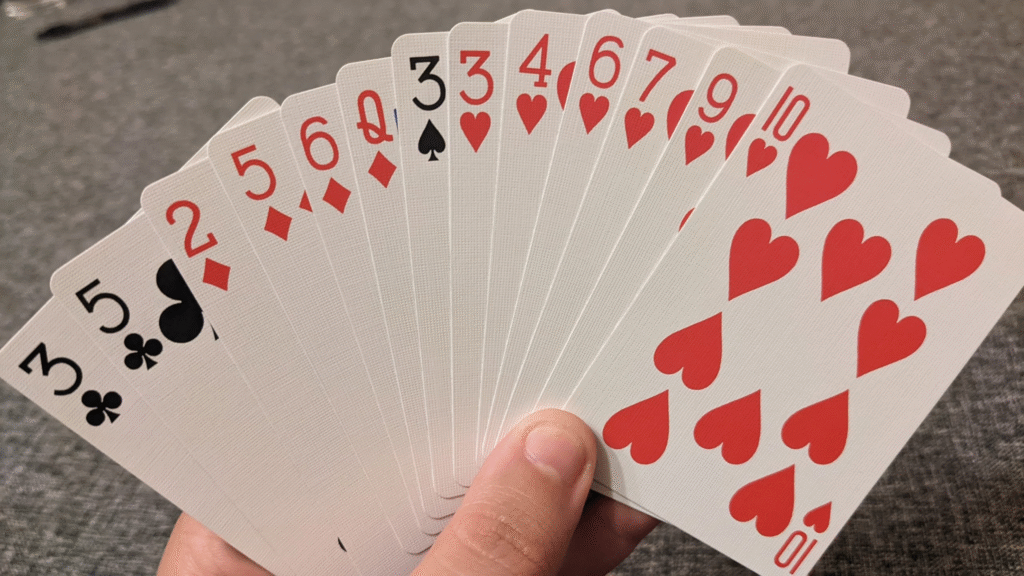A 1,500‑word deep dive into Spades, as featured on Poki via MarketJS—a timeless card game centered on bidding, partnership teamwork, and strategic play. We’ll explore its rich history, core rules, scoring nuances, strategic depth, and the appeal of playing it online.
1. A Brief History of Spades 🎴
- Origins in the 1930s United States: Born from the Whist family—alongside Bridge, Hearts, and Euchre—Spades emerged in Cincinnati around 1937–1939
- War‑time popularity: Spread across military barracks in WWII for its accessible rules, inter-play adaptability, and fewer interruptions than poker .
- Post‑war adoption: College campuses and social clubs embraced it; today, it’s a staple of trick-taking card culture across English-speaking countries
2. How to Play Spades: Rules Overview
A. Setup & Dealing
- Players: Four players in two fixed partnerships, sitting opposite each other.
- Deck: Standard 52-card pack.
- Deal: 13 cards each, clockwise from dealer; next dealer passes left
B. Bidding Phase
- Each player declares how many tricks they expect to win (0–13).
- Bids are combined per partnership—the total must be matched/taken
- Special bids: Nil (zero tricks), Blind Nil (zero without looking), with high-risk rewards
C. Playing Tricks
- Lead: Player to dealer’s left starts; must follow suit if possible.
- Trump: Spades always trump other suits. Spades cannot be led until “broken” by being played to a trump a trick
- Winning: Highest led card wins unless a spade overtrumps; highest spade wins among trump plays.
D. Scoring
- Meeting bid: 10 points per trick bid.
- Overtricks (“bags”): +1 point each, but accumulated bags (e.g., 10) lead to −100 penalty
- Underbid: −10 × bid.
- Nil success: +100 points; failure: −100. Blind nil: ±200
- Game continues until a team reaches 500 (standard) or other agreed target
3. Strategy Fundamentals
A. Effective Bidding
- Assess strengths: Count high cards—especially in spades—to set realistic bids.
- Avoid bagging: Be conservative; overtricks help opponents increment bags
- Nil tactics: Adopt Nil only with weak hand or partner’s ability to cover
B. Card Counting & Suit Control
- Track played cards—royalty and spades—to judge where to break suits or deploy trumps .
- Protect partner’s nil: Avoid overtaking if partner aims for zero; strategy: play low when opponents target your partner
C. Partner Coordination
- No table talk—communicate through your plays (e.g., playing middle cards to signal).
- Lead suit replays if beneficial; protect partner’s potential trick-winning plays
D. Advanced Moves
- Big Mo/Little Mo variants: Commit to winning first 10/7 tricks for bonus points
- 3B‑Spades / No overs: Tighter systems that penalize overtricks or bagging
4. Playing Spades Online: MarketJS
- MarketJS HTML5 port offers:
- Single-player with AI bots.
- Blind nil bidding option.
- Built-in tutorial for newcomers.
- Tie-break bonus rounds and relaxed UI
- Instant gameplay—no download needed, compatible on desktop & mobile .
- Controls: Mouse/trackpad selection, intuitive interface suitable for casual players.

5. Why Spades Still Captivates
- Quick and dynamic: Each round packs excitement in just 13 tricks and bidding strategy.
- Equal parts skill and luck: Requires card memory, timing, and partnership synergy balanced by random deal.
- Social aspect: Cooperative teamwork with partner elevates gameplay over solitaire.
- Online appeal: Offers anytime access—from casual single player to public matches accessible on platforms like cardgames.io
6. Deepening the Experience
- Bidding bots research: AI agents (e.g. BIS algorithm) can test strategic edges
- Variations galore: Customize your game with 5+ players, Joker-enhanced decks, deuce-high systems
- Communities: Online forums and subreddits (e.g., r/spades) share tips on finesse, protecting nils, and counting tricks
7. Tips from Top Players
Quotes from Reddit veterans:
“Pay attention to the cards that have been played… Don’t cut your partner’s winning trick.”
“Second low, third high.” A simple rule for mid-trick play positioning.
8. Spades vs Other Trick‑takers
- Bridge: Complex bidding, partner communication allowed—Spades is quicker and easier to learn.
- Hearts: Avoiding tricks vs capturing—you aim for prediction accuracy and partnership 🤝
- Euchre: Team trick-taking with trump variability, but Spades adds bidding and scoring layers.
9. Beginner’s Guide: Quick Start Tips
- Start conservative: Bid medium if unsure; aim to meet rather than exceed.
- Count high cards/spades: Use to predict outcomes.
- Track played cards: Notice when opponents run out of suits or spades.
- Help partner nil: Sacrifice trick wins to let them succeed.
- Play defensive: Know when to lure opponents into bagging or missing bids.
10. Final Thoughts: Why MarketJS’s Spades Still Matters
- Classic reborn: From war-time tables to modern screen—its elegance persists.
- Accessibility: Free, browser-based version opens doors for all skill levels.
- Depth with simplicity: Easy to learn; hard to master.
- Community appeal: Tutorials, forums, bots—players refine skills and build camaraderie.
Summary
- Origin: U.S. 1930s, a War‑time Whist derivative
- Goal: Bid and win exactly your tricks; use spades to trump and avoid over-tricks.
- Scoring: +10/trick, overs = +1; nils bring big swings.
- Strategy: Smart bidding, partner support, counting suits, conservative play.
- Online MarketJS version: Tutorial, AI bots, blind nil—play instantly on.
So whether you’re seeking a friendly four-player game with a partner offline, or a quick online fix with AI opponents, Spades—especially this MarketJS rendering—delivers accessible, strategic, social card fun. In 2025, its timeless design still outshines many modern card apps—and whether bidding “nil” or playing it safe, the memory of that final trick will linger.
